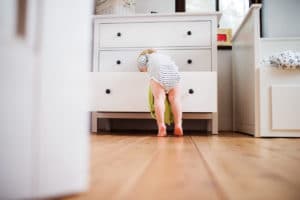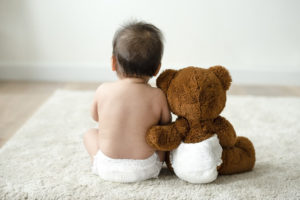How do the little ones play?
Which toy is the right one and when? That’s what many parents ask themselves when they first get to grips with the sheer endless range of toys on offer. Yet it is precisely the little ones who can amuse themselves with the simplest things. Only gradually do they conquer the colorful world of toys.
The face of the parents above the crib, a ray of sunshine on the blanket, the dancing bears of a mobile – these are baby’s first games. Play is a biological drive that is present from birth. It is the play instinct that makes people curious about everything new. Through it, he can gain countless experiences that will be useful to him in life. In the first three to four months, for example, a baby is interested in everything that comes into its field of vision. For the smallest ones, playing initially means looking. A red ball, a rattle, or other objects with clear shapes and colors are followed with the baby’s eyes. Scientists have discovered that babies are particularly attentive to faces and grimaces. Even a ping-pong paddle with eyes, mouth, and nose painted on it is an exciting affair! As the child grows older, he or she will also follow hide-and-seek, clapping, singing, or finger games with pleasure. And as time goes by, he can watch the little games for longer and longer – at first only for a few seconds, later for several minutes.
The Right Time
Parents can best capture their baby’s attention for little games when he or she is awake and physically relaxed. If he’s whining, tired, or hungry, it’s hard for him to concentrate on anything else. Parents can recognize a good time for joint games by their child’s alert gaze and shining eyes. If the child feels comfortable and secure, he or she is ready for fun experiences and stimulation.
First Experiments
Around the third month of life, babies begin to discover their own bodies. Hands, fingers, and feet become exciting play objects. With its first attempts to grasp, it also begins to explore the objects it has grabbed. Parents can always observe a similar process: at first, the baby will look at the objects intensively, then grasp and touch them, turn them around in front of his eyes and explore them with his mouth. Finally, they will actively experiment with them – knocking them on the table or rubbing them on the bedspread. Careful attention is needed as soon as the child is able to crawl and move around. At this point, objects from the wider environment become interesting, and the child fetches them to play with.
In the second half of the first year of life, toys become more important: building towers, stacking cans and arranging blocks, taking things out or putting them in, filling jars and rolling balls. These are popular games. From now on, the child wants to actively use his or her body in play and try out new skills again and again. Particularly in demand are so-called “reactive” toys, where the child can trigger an effect – for example, pressing a button so that a sound or melody is heard.
Little Games With The Grown-ups
Parents should be play partners for their offspring as often as possible. In the first year, children can hardly keep themselves busy on their own. Together with a partner, on the other hand, they enjoy experimenting and being shown new things. That’s why it’s especially important that parents like the toys and games they play with their children. While mothers may prefer to show finger games and hand puppets, fathers would rather build with building blocks or play ball games. After all, the child will only find fun in the games if his playmate is also enthusiastic.
If the child experiments independently with new discoveries, however, the grown-ups should intervene as little as possible and not direct the play according to their own ideas. As long as there is no danger from the objects, they can let their offspring play with them. Even if he doesn’t handle things as intended. Adults should always keep in mind that play is initially aimless and, above all, should be fun. It is true that there are didactic toys of all kinds for every age. But parents should not drive their children to play with certain things. After all, a child decides for itself how, what, and for how long it plays.











2 thoughts on “Toys For Babies And Newborns”